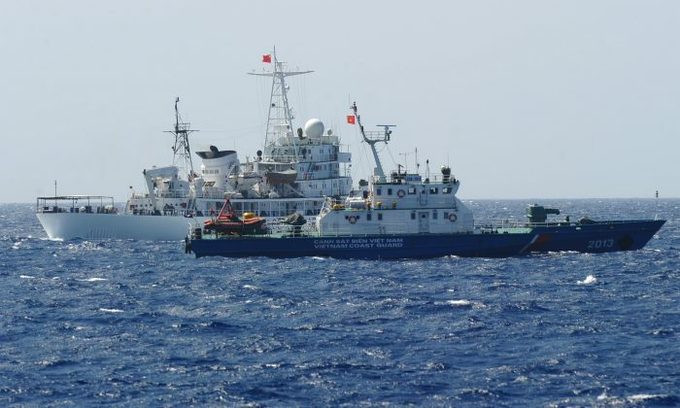This article is written by Gursimran Kaur Bakshi, a student at the National University of Study and Research in Law, Ranchi. The author of this article has extensively dealt with the laws concerning autonomous underwater vehicles (AUV), their usage both for military and non-military purposes, and their legality under international law.
Table of Contents
Introduction
Laws governing deep seas have changed drastically in the last few decades. What was once impossible, perhaps for the reason of remoteness, has now become possible with the advent of technology. The rapid use of technology has been developed for aerial, land, and maritime purposes.
But the development has been too aggressive for the accessibility of these technologies to allow superiority at the global forefront. Superiority either forces other states to pursue similar technological development or results in retaliation measures, such as the one done by China.
Growth of unmanned technology in recent times
Recently, China seized a USNS Bowditch, an unmanned underwater vehicle (UUV) being operated by a United States government vessel near the coast of the Philippines in the South China sea. China later returned it because the vehicle was conducting route operations about 50 nautical miles northwest of Subic Bay in the Philippines and that is where China does not have legal jurisdiction. While unmanned remote technology still includes human input, the same is not available for autonomous underwater vehicles (AUVs). AUVs are an attractive option for deep-sea research and it does not require any human assistance.
China was also in news for successfully testing a soft self-power autonomous robot made of a deformable silicone body in the Mariana Trench, the deepest part of the Pacific Ocean. This is unlike any other technological achievement since the autonomous robot is capable of being subjected to high pressure from the deepest point of the ocean and can be deployed for military and surveillance purposes as well.
This article will first explore the concept of Unmanned underwater vehicles vis-a-vis the UN Convention on the Law of the Sea, 1982 (UNCLOS). It will answer pertinent questions like whether UNCLOS addresses a framework for regulating AUVs, in the absence of a framework what international laws can be applied for regulating AUVs, and what are the advantages and disadvantages of using this technology.
Before addressing these questions, the article will first explain, in brief, the laws of seas.
About autonomous underwater vehicles
Overview of UNCLOS
UNCLOS divides the sea into three parts, the first is the Territorial sea, which is measured from the baseline of a state which is its land boundary to 12 Nautical Miles (NM). This is the portion where the state exercises its absolute sovereignty. From 12 NM of the territorial sea to another 12 NM, which is 24 in total from the baseline, is the Contiguous zone.
Next is the Exclusive Economic Zone (EEZ) which extends from the baseline to 200 NM where coastal states have sovereign rights for exploring, exploiting, conserving, and managing living and non-living resources such as coral reefs, oil, and gas to name a few. Beyond the EEZ is the high sea. No state can claim sovereignty which is also known as res communis, a concept that is preceded by the common heritage of mankind, in the high seas. States have freedom of navigation on the high seas and it is open to all states as per Article 87 of the UNCLOS. Since all states can exercise freedom and no state can claim it, this portion is also governed by other rules of international law in addition to UNCLOS.
About AUVs
The AUVs use advanced navigation and control systems against those being remotely operated by humans. It is designed to explore and exploit a deep oceanic environment. As maritime operation expands into deep waters and remote locations, there arises a need for more effective technology which provides a better gathering of information.
The new technology is advantageous because it can simply be given instructions to perform a certain task and come back to its original location. AUVs can come in various forms, such as it could be developed to allow self-propulsion or being environmentally able. Currently, there is also a development on using AUVs for cargo load which was once only restricted to those vessels engaged in commerce and navigation.
Now, the issue with AUVs is in regards to their regulatory framework. The UNCLOS does not recognise AUVs and in other laws such as the US maritime laws, the definition of the vessel is understood for the context of commerce and navigation. Whereas, AUVs are not meant to be used for such purposes and that is why there is a regulatory gap. Let’s understand the different defines of vehicle/vessel under UNCLOS and other laws.
UNCLOS does not differentiate between UUVs and AUVs
UUV is a robotic technology that is divided into two categories of Remotely Operated Underwater Vehicles (ROUV) and AUV. UUVs are and should ideally be used to explore the depth of the oceans for scientific advancement, deep-sea exploration, research, and countermining purposes. It comes with cutting-edge technology that could be deployed for maritime security such as piracy and terrorism, surveillance, and illegitimate territorial claims to name a few.
While the use of remotely-operated technology could be considered as an extension of the vessel operated through human input, the same cannot be said for those operated without any human assistance. There are common concerns associated with the use of unmanned technology especially during the current time when they are being used for aggressive technological developments.
The UNCLOS does not differentiate between autonomous or remotely controlled vehicles. It also does not define terms like vessel and vehicle. It does not extensively deal with this aspect and discusses the undersea vehicle only within the context of the innocent passage under Article 20. This Article states that undersea vehicles are supposed to navigate on the surface with the state flag on the territorial waters of the sea.
Innocent passage as defined under Article 19 allows foreign vessels to pass through the territorial waters of another state, provided, that the passage is not prejudicial to the peace, good order, or security of a coastal state such as it is exercised with weapons for any kind, launching or landing of any military device, or any the sovereignty and territorial integrity to name a few. However, apart from this, UNCLOS does not mention anything else about undersea vehicles.
Examples of UUVs are submarines. They are used by states for collecting oceanographic information, undersea cable repair, deep-sea research, search and rescue operations, and for military purposes. UUVs are also used in tapping or disrupting communication cables which are used to carry signals and data for both civilian and military purposes. In the latter case, intelligence gathering is done by states trying to get information against the rival country. For instance, in 2015, a Russian submarine and spy ships operated near the US undersea communication cables.
Legal framework for AUVs under international law
The first issue with AUVs is whether it is classified within the class of undersea vehicle or not. The answer to this is no. The UNCLOS does not contain any definition provisions on undersea vehicles. It only discusses the same in the context of innocent passages. Thus, a reference to UNCLOS would be inadequate in the context of AUVs.
The term ‘vessel’ apart from UNCLOS may find a definition in Section 3 of the Rules for Construction of the U.S Code as ‘every description of watercraft or other artificial contrivance used, or capable of being used, as a means of transportation on water.’ Similarly, another US maritime law, the International Regulations for Preventing Collisions at Sea (COLREG), defines a vessel as every description of watercraft including non-displacement craft and seaplanes capable of transportation on water.
These definitions make one thing clear. The vehicle/vessel must be used for commercial purposes. Whereas, the same cannot be said for AUVs because they are not known to be used for such purposes. Their usage is specific for deepsea exploration and for things that are not possible with manned technology. Thus, these rules have no application on AUVs.
But that does not mean that AUVs are absolutely outside the ambit of US maritime laws. As mentioned above, the definition of vessels requires that they must be able to be used for commerce and navigation. Certain classes of AUVs may then be subjected to the laws if they are used for the trade purposes such as cargo carrying AUVs. That is why countries are currently trying to explore the use of AUVs for commercial purposes.
Other than this, a definition of a ship is available in the International Convention for the Prevention of Pollution of the Sea by Oil, 1954 (as amended in 1969). The Convention defines ships under Article 1 as those capable of making a sea voyage. It may include any sea-going vessel of any type including floating craft, whether self-propelled or towed by another vessel. All these definitions may or may not include AUVs within the ambit depending on the purpose of its usage.
Use of AUVs in military applications
Further, there is another debate on the possibility of AUVs being classified as warships. Article 29 of UNCLOS defines a warship as a ship belonging to the armed forces of a state bearing external marks distinguishing such ships of its nationality, under the commander of an officer duly commissioned by the government of the state and whose name appears in the appropriate service list or its equivalent and manned by a crew which is under regular armed forces discipline.
While terms like vessels and vehicles may both being used in UNCLOS, they have mostly been referred to in the context of their navigational rights. The same set of rights and protection is not available to a warship under UNCLOS such as in Article 30, a warship prejudice to the interest of the coastal state needs to leave the water immediately. Moreover, UUVs used for military purposes cannot be the same used for navigational purposes as both are designed for two entirely different purposes and one is a manned technology and another one is unmanned.
Legal challenges of using AUVs
Since the UNCLOS does not define what a vessel or vehicle means in terms of understanding the regulatory mechanism for the same, the same becomes problematic for defining an AUV. It is not possible to maintain undersea communication effectively as it requires expensive technology such as acoustic communication.
Currently, the shift from completely autonomous vehicles for the purposes of military application is limited as it requires a lot of military investment and development. It is indeed true that increased autonomy gives a substantial advantage in warfighting. But it should be noted that no machine is entirely capable of being autonomous. The AUV system refers to increased autonomous capacities and not the system. Still, the use of AUVs for military purposes remains an anticipated and unexplored area.
Moreover, there are ethical issues with AUVs, as many international scholars have debated, similar to unmanned weapons. This technology is also used by states for military purposes such as intelligence, surveillance and reconnaissance. It could potentially be used in future naval warfare since they are developed in a way to perform attacks similar to anti-submarine warfare. Apart from the traditional-looking AUVs, there have been recent innovations of AUVs made by silicone material which can sustain for a longer period and can even be operated in the deepest parts of the ocean which is the Mariana trench apart from the one developed by China already.
Thus, these technologies are expensive and thus, not all states can have access to the same. But, there is a common consensus that it offers maritime superiority. Second, the threshold associated in terms of liability and responsibility with the access and use of autonomous technology is unclear because of the lack of uniform laws regulating the same. It can be anticipated that the same should be much higher than the remotely operated ones because the robotic technology is capable of achieving the unknown.
Use of UUVs including AUVs for various purposes by States
The United States is planning to procure three types of unmanned vehicles which include extra-large UUV. US’s Department of Navy has launched an unmanned campaign framework in 2021, that seeks to effectively deploy unmanned vehicles in the navy that will be more lethal and capable of effectively achieving its purpose. It will provide a framework on how to use this technology. US is planning to launch Orca Extra Large UUV which can be used for operational awareness and will accommodate large payloads, the first model of which will be completed in 2022.
The US has also ordered two Remote Environmental Monitoring Units 300 UUVs, which are built for military and commercial applications, such as mine countermeasures and search and recovery from the Huntington Ingalls Industries.
China also owns UUVs. Recently, it showed off a large UUV HSU-001 which may be deployed for intelligence gathering purposes, especially against the US and its allies. China has a habit of claiming its right over unnamed territories, lands, and even parts of the South China sea under its string of pearls policy to make its presence in the Indian Ocean region. It also has indigenously developed Qianlong III and Haiya which are AUVs.
China recently seized a US Navy UUV in the high sea, which was 50-100 NM off the Philippines’ Subic Bay port. This is another example of how China consistently tries to assert and challenges the powers of other states which in turn instigates states to deploy vehicles to retaliate.
Russia is also planning to launch its UUV which is reportedly armed with megaton-class nuclear warheads. The UUV code-named as Kanyon by the US would be used against it to target both naval ports used by the U.S Navy’s submarine fleet and its coastal regions.
Conclusion
The future of UUV looks critical, for states that are now more interested in exploitation and if not exploitation then over-concerned about their naval security. While this issue makes it evident that the players betting on this technology are the developed states with financial capacity, the same may prove detrimental for the others. Deepsea remains an unknown area and it certainly makes many states curious over how it can be explored and the opportunities waiting in this aspect. Since unmanned technology has its set of advantages, it is obvious that it carries with it disadvantages as well. These disadvantages cannot be overlooked upon by states who are at the forefront of their maritime development.
References
- https://www.naval-technology.com/features/autonomous-underwater-robots-navy/
- https://legal.un.org/diplomaticconferences/1958_los/
- https://www.itlos.org/en/
- https://legal.un.org/ilc/guide/annex3.shtml
- https://www.un.org/depts/los/convention_agreements/texts/unclos/part17.htm
- https://core.ac.uk/download/pdf/235289197.pdf
- https://international-review.icrc.org/sites/default/files/irc98_10.pdf
- https://legal.un.org/ilc/texts/instruments/english/conventions/1_1_1969.pdf
- https://www.refworld.org/docid/453883fd1f.html
LawSikho has created a telegram group for exchanging legal knowledge, referrals, and various opportunities. You can click on this link and join:
 Serato DJ Crack 2025Serato DJ PRO Crack
Serato DJ Crack 2025Serato DJ PRO Crack











 Allow notifications
Allow notifications



